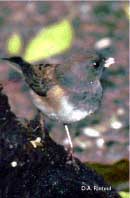 In northeastern Ohio, the only area in the state where dark-eyed juncos nest regularly, the preferred habitat for the birds is wet woods of mature hemlock and deciduous trees with plenty of undergrowth (Peterjohn, 1991).
In northeastern Ohio, the only area in the state where dark-eyed juncos nest regularly, the preferred habitat for the birds is wet woods of mature hemlock and deciduous trees with plenty of undergrowth (Peterjohn, 1991).
Since completion of the state's breeding bird atlas project, the species may have expanded its breeding area slightly; but the number of individual birds present each summer has increased markedly (Rosche, 2002).
Dark-eyed juncos usually nest on the ground in a spot sheltered by roots, rocks, tussocks or branches. Occasionally, juncos will nest off the ground, even on man-made structures (Bent, 1968).
However, I have seen only one reference to a junco nest inside a human habitation, and that was to one in a woodshed attached to the back of someone's home (Forbush, 1929).
Consequently, when my grandson Sam told me that juncos were building a nest in his family's attached garage in Orange Village, I didn't believe him--until I had a chance to look for myself. Eight feet inside, five feet above the floor of the garage, nestled in the center of a Christmas tree stand hanging on the watt, juncos had a nest of fine grass and moss well underway on the third or fourth of May, 2003.
On the ninth there were three eggs in the nest, the complete clutch as it turned out. I observed an adult junco on the eggs on the thirteenth but was unable to determine just how long incubation had been
going on.
On the morning of the seventeenth, a bird was still on the nest; but by 5:30
p.m. two eggs had hatched. A third must have hatched early that evening.
By the 28th the young filled the nest to overflowing and appeared completely feathered except for down on their heads. Early on the 29th the first of the brood left the nest; by late afternoon all three were out.
Although all three young got out of the garage successfully, one of them followed Sam back into the garage late in the afternoon, could not find its way out again, chirped loudly as long as Sam's family was outside, and was found dead beneath the nest the next morning.
I can't help wondering if the bird had imprinted on Sam during his observations of the nest and young. On the morning of the 30th, the adults continued flying in and out of the garage, and the surviving young were
audible chirping in bushes near the garage.
This nesting record raises at least two questions. First, why juncos chose such a nest site when the immediate area, though flat, was damp and largely wooded with numerous clearings, providing many more natural locations? The garage faces south, and the door was open all day every day.
The cavity in the tree stand, though several feet above the floor, provided both the preferred overhang and proximity to a vertical surface (Bent, 1968). Though these characteristics my be interpreted as positives, it is also true that the nest was directly opposite the door into the house, which was constantly used early and late in the day by two adults, 3 noisy children, and a noisier large dog.
Second, how could the birds carry out a successful nesting? In addition to the traffic in and out of the garage, the garage door was closed at night. Apparently, the household schedule conformed to the needs of the juncos.
Nest building, as well as feeding and caring for the young, did not take place between
dusk and sunrise. During incubation and the days of brooding the young, the
attending adult bird clearly was not inconvenienced or threatened by being closed
in at night. In fact, the birds were thereby protected from marauding raccoons and other predators.
Though I don't expect the nesting described here to be a precursor of more domestic interactions of juncos with humans, I find real satisfaction in this example of accommodation between birds and people.
I am also delighted that my grandchildren found so much pleasure in observing all stages of the nesting sequence.
Bent, A.C. 1968. LIFE HISTORIES OF NORTH AMERICAN CARDINALS, GROSBEAKS, BUNTINGS, TOWHEES, FINCHES, SPARROWS, AND ALLIES, Part two. Dover Publications Inc., New York N.Y.
Forbush, E.H. 1929. BIRDS OF MASSACHUSETTS AND OTHER NEW ENGLAND STATES, Vol. 3. Massachusetts Dept. of Agriculture. Peterjohn, B.G. and D.L.Rice. 1991.
THE OHIO BREEDING BIRD ATLAS. The Ohio Department of Natural Resources, Columbus, Ohio. Rosche, L. 2002. "Noteworthy Records." THE CLEVELAND BIRD CALENDAR. 98 (3) :38.
Provided by The Kirtland Bird Club.
Written by Dick Rickard
Top of Page
Back to Birdwatching for Cleveland Seniors

